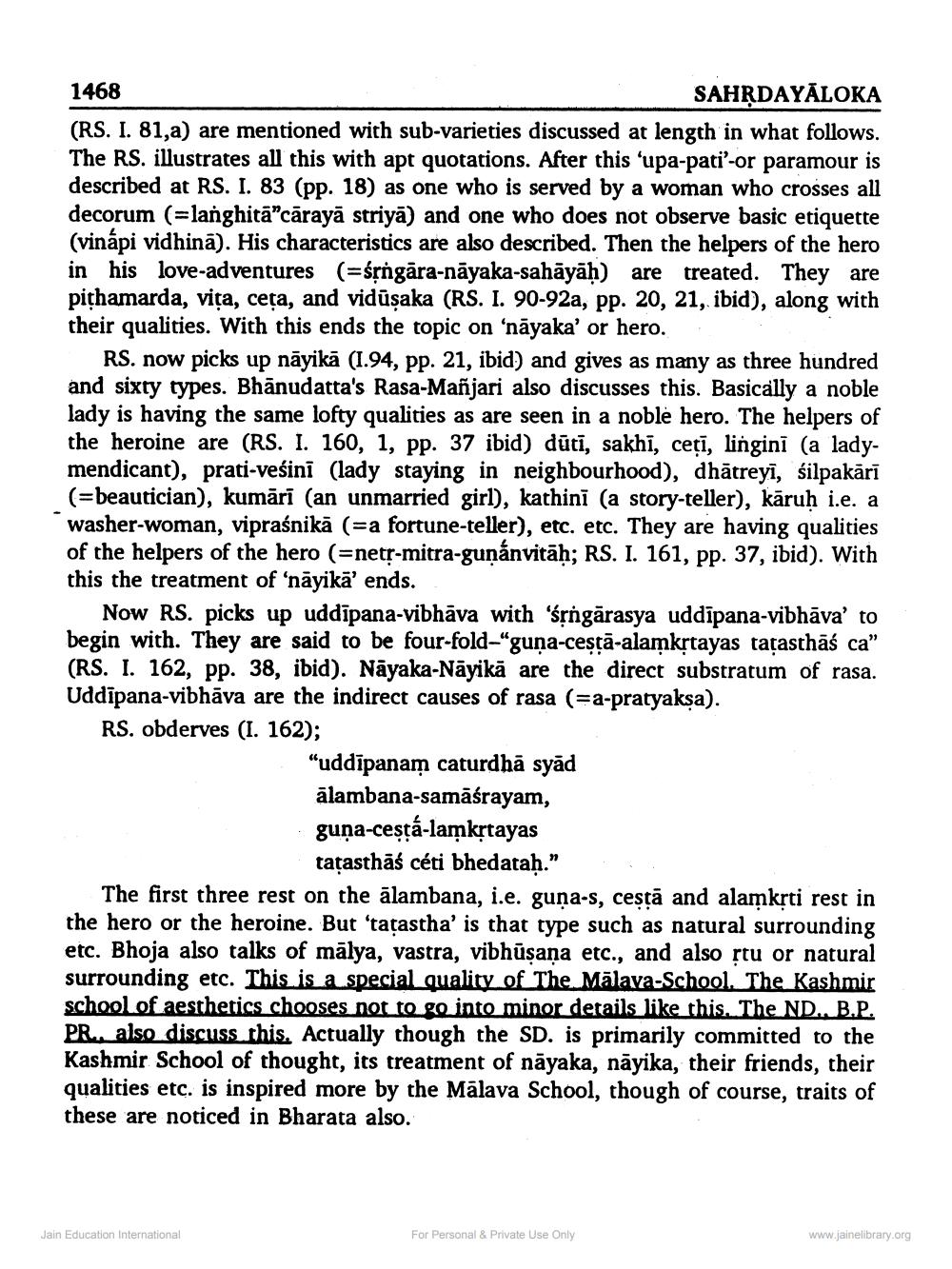________________
1468
SAHRDAYĀLOKA
(RS. I. 81,a) are mentioned with sub-varieties discussed at length in what follows. The RS. illustrates all this with apt quotations. After this 'upa-pati'-or paramour is described at RS. I. 83 (pp. 18) as one who is served by a woman who crosses all decorum (=langhitā"cārayā striyā) and one who does not observe basic etiquette (vinápi vidhina). His characteristics are also described. Then the helpers of the hero in his love-adventures (=śřngāra-nāyaka-sahāyāḥ) are treated. They are pithamarda, vita, ceta, and vidūşaka (RS. I. 90-92a, pp. 20, 21, ibid), along with their qualities. With this ends the topic on 'nāyaka' or hero.
RS. now picks up nāyikā (1.94, pp. 21, ibid) and gives as many as three hundred and sixty types. Bhānudatta's Rasa-Mañjari also discusses this. Basically a noble lady is having the same lofty qualities as are seen in a noble hero. The helpers of the heroine are (RS. I. 160, 1, pp. 37 ibid) dūtī, sakhi, ceļī, lingini (a ladymendicant), prati-vesini (lady staying in neighbourhood), dhātreyī, śilpakārī (=beautician), kumārī (an unmarried girl), kathini (a story-teller), kāruh i.e. a washer-woman, vipraśnikā (=a fortune-teller), etc. etc. They are having qualities of the helpers of the hero (=netr-mitra-gunánvitāḥ; RS. I. 161, pp. 37, ibid). With this the treatment of 'nāyikā’ends.
Now RS. picks up uddīpana-vibhāva with 'śộngārasya uddīpana-vibhāva to begin with. They are said to be four-fold-guna-cestā-alamkrtayas tatasthāś ca" (RS. I. 162, pp. 38, ibid). Nāyaka-Nāyikā are the direct substratum of rasa. Uddipana-vibhāva are the indirect causes of rasa (=a-pratyaksa). RS. obderves (I. 162);
"uddīpanam caturdhā syād alambana-samāśrayam, guna-cestá-lamkrtayas
taţasthāś céti bhedataḥ.” The first three rest on the ālambana, i.e. guna-s, cestā and alamkrti rest in the hero or the heroine. But 'taţastha' is that type such as natural surrounding etc. Bhoja also talks of mālya, vastra, vibhūsana etc., and also rtu or natural surrounding etc. This is a special quality of The Mälava-School. The Kashmir school of aesthetics chooses not to go into minor details like this. The ND.. B.P. PR. also discuss this. Actually though the SD. is primarily committed to the Kashmir School of thought, its treatment of nāyaka, nāyika, their friends, their qualities etc. is inspired more by the Mālava School, though of course, traits of these are noticed in Bharata also.
Jain Education International
For Personal & Private Use Only
www.jainelibrary.org




